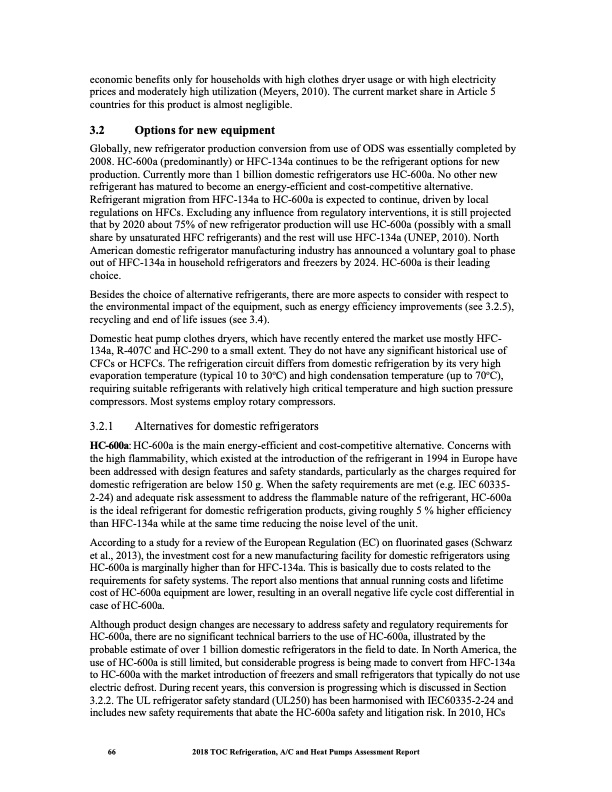
PDF Publication Title:
Text from PDF Page: 079
economic benefits only for households with high clothes dryer usage or with high electricity prices and moderately high utilization (Meyers, 2010). The current market share in Article 5 countries for this product is almost negligible. 3.2 Options for new equipment Globally, new refrigerator production conversion from use of ODS was essentially completed by 2008. HC-600a (predominantly) or HFC-134a continues to be the refrigerant options for new production. Currently more than 1 billion domestic refrigerators use HC-600a. No other new refrigerant has matured to become an energy-efficient and cost-competitive alternative. Refrigerant migration from HFC-134a to HC-600a is expected to continue, driven by local regulations on HFCs. Excluding any influence from regulatory interventions, it is still projected that by 2020 about 75% of new refrigerator production will use HC-600a (possibly with a small share by unsaturated HFC refrigerants) and the rest will use HFC-134a (UNEP, 2010). North American domestic refrigerator manufacturing industry has announced a voluntary goal to phase out of HFC-134a in household refrigerators and freezers by 2024. HC-600a is their leading choice. Besides the choice of alternative refrigerants, there are more aspects to consider with respect to the environmental impact of the equipment, such as energy efficiency improvements (see 3.2.5), recycling and end of life issues (see 3.4). Domestic heat pump clothes dryers, which have recently entered the market use mostly HFC- 134a, R-407C and HC-290 to a small extent. They do not have any significant historical use of CFCs or HCFCs. The refrigeration circuit differs from domestic refrigeration by its very high evaporation temperature (typical 10 to 30oC) and high condensation temperature (up to 70oC), requiring suitable refrigerants with relatively high critical temperature and high suction pressure compressors. Most systems employ rotary compressors. 3.2.1 Alternatives for domestic refrigerators HC-600a: HC-600a is the main energy-efficient and cost-competitive alternative. Concerns with the high flammability, which existed at the introduction of the refrigerant in 1994 in Europe have been addressed with design features and safety standards, particularly as the charges required for domestic refrigeration are below 150 g. When the safety requirements are met (e.g. IEC 60335- 2-24) and adequate risk assessment to address the flammable nature of the refrigerant, HC-600a is the ideal refrigerant for domestic refrigeration products, giving roughly 5 % higher efficiency than HFC-134a while at the same time reducing the noise level of the unit. According to a study for a review of the European Regulation (EC) on fluorinated gases (Schwarz et al., 2013), the investment cost for a new manufacturing facility for domestic refrigerators using HC-600a is marginally higher than for HFC-134a. This is basically due to costs related to the requirements for safety systems. The report also mentions that annual running costs and lifetime cost of HC-600a equipment are lower, resulting in an overall negative life cycle cost differential in case of HC-600a. Although product design changes are necessary to address safety and regulatory requirements for HC-600a, there are no significant technical barriers to the use of HC-600a, illustrated by the probable estimate of over 1 billion domestic refrigerators in the field to date. In North America, the use of HC-600a is still limited, but considerable progress is being made to convert from HFC-134a to HC-600a with the market introduction of freezers and small refrigerators that typically do not use electric defrost. During recent years, this conversion is progressing which is discussed in Section 3.2.2. The UL refrigerator safety standard (UL250) has been harmonised with IEC60335-2-24 and includes new safety requirements that abate the HC-600a safety and litigation risk. In 2010, HCs 66 2018 TOC Refrigeration, A/C and Heat Pumps Assessment ReportPDF Image | Heat Pumps Technical Options

PDF Search Title:
Heat Pumps Technical OptionsOriginal File Name Searched:
RTOC-assessment-report-2018_0.pdfDIY PDF Search: Google It | Yahoo | Bing
CO2 Organic Rankine Cycle Experimenter Platform The supercritical CO2 phase change system is both a heat pump and organic rankine cycle which can be used for those purposes and as a supercritical extractor for advanced subcritical and supercritical extraction technology. Uses include producing nanoparticles, precious metal CO2 extraction, lithium battery recycling, and other applications... More Info
Heat Pumps CO2 ORC Heat Pump System Platform More Info
| CONTACT TEL: 608-238-6001 Email: greg@infinityturbine.com | RSS | AMP |